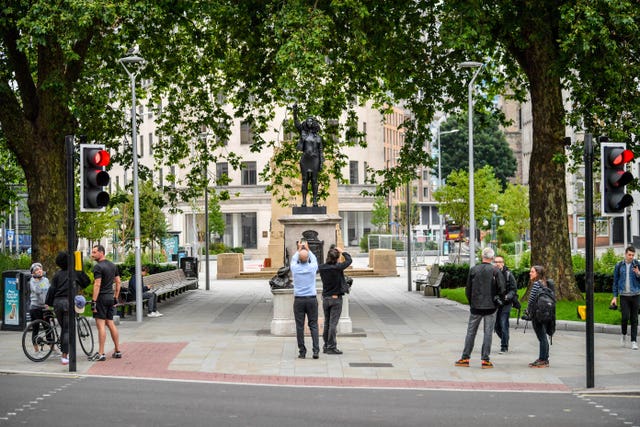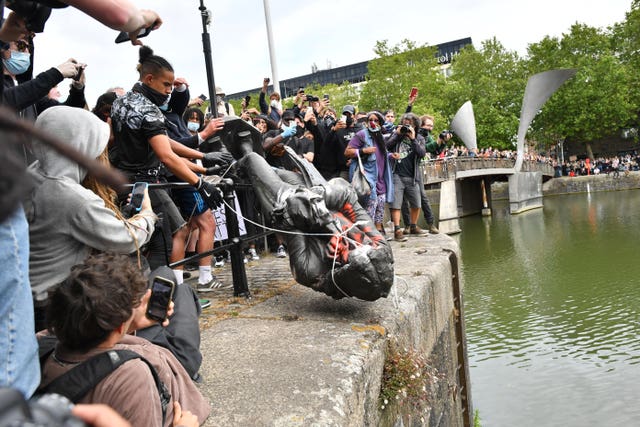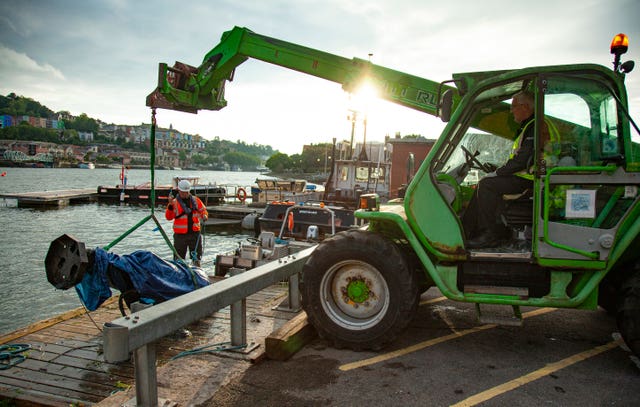A sculpture of a black woman who took part in a Black Lives Matter protest in Bristol has been erected on the plinth where a statue of slave trader Edward Colston used to stand.
Artist Marc Quinn created the life-size black resin and steel piece of Jen Reid, from Bristol, after seeing a photograph of her standing on the empty plinth after the Colston statue was toppled.
The sculpture, entitled A Surge of Power (Jen Reid), was erected shortly before 5am on Wednesday by Quinn’s team without the knowledge or consent of Bristol City Council.
Mayor Marvin Rees previously said any decision on how the plinth should be used would be decided democratically through consultation.
After the sculpture was installed on the plinth, Mrs Reid stood in front of it with her fist in the air.
She recalled climbing onto it after the Colston statue was pulled down and spontaneously raising her arm in a Black Power salute.

“It was like an electrical charge of power was running through me,” the stylist said.
“My immediate thoughts were for the enslaved people who died at the hands of Colston and to give them power.
“I wanted to give George Floyd power, I wanted to give power to Black people like me who have suffered injustices and inequality. A surge of power out to them all.”

She added: “Creating this sculpture is so important as it helps keep the journey towards racial justice and equity moving, because black lives matter every day.
“This sculpture is about making a stand for my mother, for my daughter, for black people like me. It’s about black children seeing it up there.
“It’s something to feel proud of, to have a sense of belonging, because we actually do belong here and we’re not going anywhere.”

On June 7, protesters on the Black Lives Matter march used ropes to pull the Colston statue from its plinth in the city centre.
It was dragged to the harbourside, where it was thrown in the water at Pero’s Bridge – named in honour of enslaved man Pero Jones who lived and died in the city.
Mrs Reid described the moment of the Colston statue being thrown into the river as “a truly historical moment”.
Bristol City Council retrieved the statue on June 11 and said it would be displayed in a museum along with placards from the Black Lives Matter protest.
Mr Quinn’s previous works include self-portrait Self and a sculpture entitled Alison Lapper Pregnant, for the fourth plinth in Trafalgar Square.

The artist, who had been following events following the death of George Floyd, contacted Mrs Reid after a friend showed him a photograph on Instagram of her stood on the plinth.
“My first, instant thought was how incredible it would be to make a sculpture of her, in that instant,” he said.
“It is such a powerful image, of a moment I felt had to be materialised, forever. I contacted Jen via social media to discuss the idea of the sculpture and she told me she wanted to collaborate.”
He added: “The plinth of Edward Colston in Bristol seems the right place to share this sculpture about the fight against racism, which is undoubtedly the other virus facing society today.”
Mr Quinn said the sculpture was not being put on the plinth as a “permanent solution”.
“We want to keep highlighting the unacceptable problem of institutionalised and systemic racism that everyone has a duty to face up to,” he said.
He described the sculpture as “an embodiment and amplification” of Mrs Reid’s ideas and experiences.





Comments: Our rules
We want our comments to be a lively and valuable part of our community - a place where readers can debate and engage with the most important local issues. The ability to comment on our stories is a privilege, not a right, however, and that privilege may be withdrawn if it is abused or misused.
Please report any comments that break our rules.
Read the rules hereLast Updated:
Report this comment Cancel